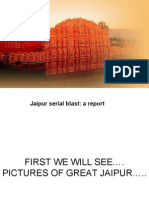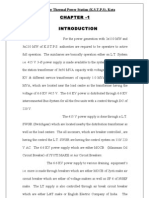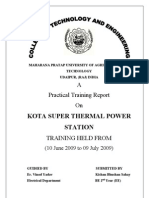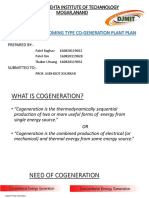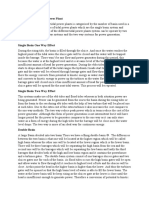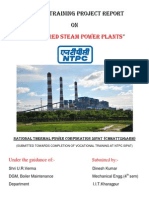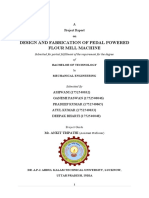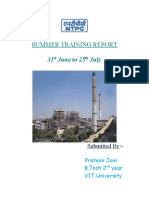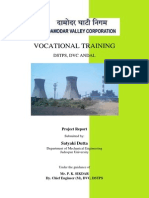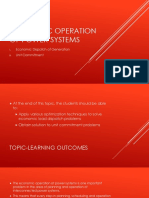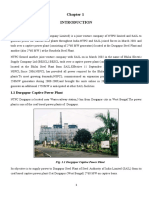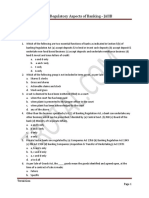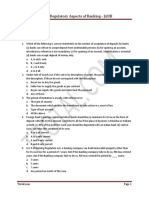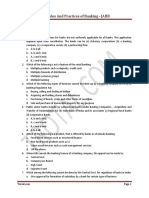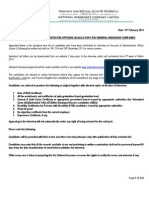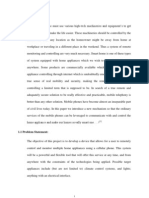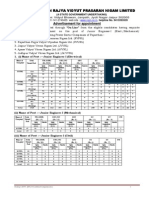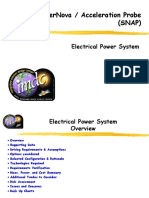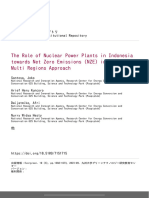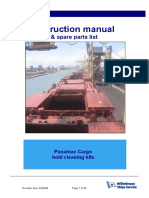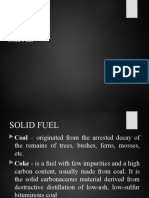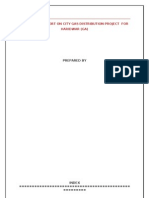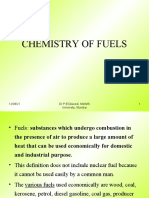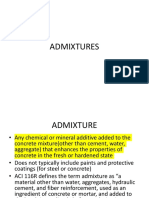Kota Super Thermal Power Plant
Kota Super Thermal Power Plant
Uploaded by
atul mishraCopyright:
Available Formats
Kota Super Thermal Power Plant
Kota Super Thermal Power Plant
Uploaded by
atul mishraCopyright
Available Formats
Share this document
Did you find this document useful?
Is this content inappropriate?
Copyright:
Available Formats
Kota Super Thermal Power Plant
Kota Super Thermal Power Plant
Uploaded by
atul mishraCopyright:
Available Formats
Introduction
INTRODUCTION Rajasthan is well on its way for a 'brighter' future, a future that promises electricity to every city, town and village of the state, a promise of making the state completely self-dependent in power production. The state plans to add over 1500 megawatts of power supply to its present capacity in the coming two years. Nine electricity generating units are being raised under different power projects across the state that will increase the current capacity of 2,569 MW to 4084 MW. Kota Thermal Power Station is Rajasthan's First major coal power station. Presently it is in operation with installed capacity of 1240 MW. And one more unit of 250MW is slated for commissioning in March 2009. The foundation of seventh unit of Kota Thermal Power Station (KTPS) was laid by Union Minister of Power, Mr. Sushil Kumar Shinde on December 5, 2006. The unit is expected to be ready by November, 2007. After this, the Kota power plant's present capacity of 1045 MW will be expanded to 1240 MW.
STAGE UNIT NO. CAPACITY(MW) SYNCHRONIZING DATE COST (Rs. crore)
1 2 3 4 5 6 7
110 110 210 210 210 195 195
17.01.1983 13.07.1983 25.09.1988 01.05.1989 26.03.1994 31.07.2003 30.05.2009
143 480 480 635 880
II
III IV V
Introduction
Location: Kota Thermal Power Station is located on the left bank of river Chambal in Rajasthan's principal Industrial city, Kota. Thermal power station to produce electrical power for supply undertakings K.S.T.P.S. is designed for ultimate capacity of 1240 MW.
Excellent Performance: Kota Thermal Power Station of RVUN is reckoned one of the best, efficient and prestigious power stations of the country. KTPS has established a record of excellence and has earned meritorious productivity awards from the Ministry of Power, Govt. of India during 1984, 1987, 1989, 1991& every year since 1992-93 onwards. Kota Super thermal power station have earned Golden Shield award from Union Ministry of power for consistently outstanding performance during last four years (i.e. 2000-01,200102,2002-03,2003-04). The Golden Shields were presented by H.E. President of India Dr. A.P.J. Abdul Kalam on 24.08.2004.
Power Station Design
POWER STATION DESIGN Power station design requires wide experience. A satisfactory design consists of the following Steps: Selection of site Estimation of capacity of power station. Selection of turbines and their auxiliaries. Selection of boilers, and their auxiliaries. Design of fuel handling system. Selection of condensers. Design of cooling system. Design of piping system to carry steam and water. Selection of electrical generator.
Characteristics of a Steam Power Plant : The desirable characteristic for a steam power plant are as follows: Higher efficiency. Lower cost. Ability to burn coal especially of high ash content and inferior coals. Reduced environmental impact in terms of air pollution. Reduced water requirement. Higher reliability and availability.
Coal Handling Plant
COAL HANDLING PLANT Coal delivery equipment is one of the major components of plant cost. The various steps involved in coal handling are as follows: 3.1 Steps in coal handling Coal Delivery
Unloading
Preparation
Transfer
Outdoor Storage (Dead Storage)
Covered Storage (Live Storage)
In Plant Handling
Weighing and Measuring
Furnace
Fig. 1 Steps in Coal Handling.
Coal Handling Plant
Coal Delivery The coal from supply points is delivered by ships or boats to power stations situated near to sea or river whereas coal is supplied by rail or trucks to the power stations which are situated away from sea or river. The transportation of coal by trucks is used if the railway facilities are not available. Unloading
The type of equipment to be used for unloading the coal received at the power station depends on how coal is received at the power station. If coal is delivered by trucks, there is no need of unloading device as the trucks may dump the coal to the outdoor storage. Coal is easily handled if the lift trucks with scoop are used. In case the coal is brought by railway wagons, ships or boats, the unloading may be done by car shakes, rotary car dumpers, cranes, grab buckets and coal accelerators. Rotary car dumpers although costly are quite efficient for unloading closed wagons.
Fig. 2 Railway wagons
Coal Handling Plant
Preparation When the coal delivered is in the form of big lumps and it is not of proper size, the preparation (sizing) of coal can be achieved by crushers, breakers, sizers driers and magnetic separators. Transfer After preparation coal is transferred to the dead storage by Belt conveyors, Screw conveyors, Bucket elevators, Grab bucket elevators, Skip hoists, Flight conveyor.
Fig. 3 Receiving Conveyor System
Coal Handling Plant
Outdoor (Dead) Storage It is desirable that sufficient quantity of coal should be stored. Storage of coal gives protection against the interruption of coal supplies when there is delay in transportation of coal or due to strikes in coal mines. Also when the prices are low, the coal can be purchased and stored for future use. The amount of coal to be stored depends on the availability of space for storage, transportation facilities, the amount of coal that will whether away and nearness to coal mines of the power station. Usually coal required for one month operation of power plant is stored in case of power stations situated at longer distance from the collieries whereas coal need for about 15 days is stored in case of power station situated near to collieries. Storage of coal for longer periods is not advantageous because it blocks the capital and results in deterioration of the quality of coal.
Indoor (Live) Storage Such storage constitutes coal requirements of the plant for a day. The live storage can be provided with bunkers and coal bins.
In Plant Handling This refers to handling of coal between the final storage to the firing equipment. In case of simple stoker firing only chutes may be required to feed the coal from storage bunker to firing units.
Coal Weighing The cost of the fuel is the major running cost of the plant. It is, therefore, very necessary to weigh coal at unloading point and also that used as feed to individual boilers. A correct measurement of coal enables one to have an idea of total quantity of coal delivered at the site and also whether or not proper quantity has been burned as per load on the plant.
Coal Handling Plant
3.2 PULVERIZATION OF COAL
Fig. 4 coal pulverizer
Coal is pulverized (powdered) to increase its surface exposure thus permitting rapid combustion. Efficient use of coal depends greatly on the combustion process employed. For large scale generation of energy the efficient method of burning coal is confined still to Pulverized coal combustion. The pulverized coal is obtained by grinding the raw coal in pulverizing mills. The various pulverizing mills used are as follows: Ball mill Hammer mill Ball and race mill
Coal Handling Plant
3.3 PULVERIZED COAL FIRING
Fig. 5 fuel burner Hot air is passed through coal in the feeder to dry the coal. The coal is then transferred to the pulverizing mill where it is pulverized. Primary air is supplied to the mill, by the fan. The mixture of pulverized coal and primary air then flows to burner where secondary air is added. The unit system is so called from the fact that each burner or a burner group and pulverising constitutes a unit.
3.4 ASH DISPOSAL A large quantity of ash is, produced in steam power plants using coal. Ash produced in about 10 to 20% of the total coal burnt in the furnace. Handling of ash is a problem because ash coming out of the furnace is too hot, it is dusty and irritating to handle and is accompanied by some poisonous gases.(2)
Thermal Power Plant Equipment
EQUIPMENTS ON A THERMAL POWER STATION 4.1 Boiler Boiler is a device meant for producing steam under pressure. Steam boilers are broadly classified into fire tube and water tube. Generally water tube boilers are used for electric power station. In water tube boilers, water circulates through the tubes and hot products of combustion flow over these tubes. In fire tube boiler the hot products of combustion pass through the tubes, which are surrounded, by water. But they are more likely to explosion, water volume is large and due to poor circulation they cannot meet quickly the change in steam demand. Water tube boilers require less weight of metal for a given size, are less liable to explosion, produce higher pressure, are accessible and can response quickly to change in steam demand. Tubes and drums of water-tube boilers are smaller than that of fire-tube boilers and due to smaller size of drum higher pressure can be used easily. Water-tube boilers require lesser floor space. The efficiency of water-tube boilers is more. (1) Boiler is main equipment on a thermal power station. It made up of thousands of tubes Generally called water walls. And these walls are insulated by the insulating material. And water is flowing through these tubes. And the height of the boiler is approx. 55-60 meter. The plant efficiency is mainly depending upon boiler efficiency.
Fig. 6 inside view of a boiler furnace
10
Thermal Power Plant Equipment
Fig. 7 Boiler house Component
TECHNICAL SPECIFICATION OF BOILER (2x110MW UNITS) 1. Type : Direct fired, natural circulation balance draft water tube Boiler . 2. No. of Units. 3. Make 4. Capacity. 5. Steam Pressure. 6. Efficiency : : : : : Two. BHEL. 375 tones per hour. 139 Kg./Cm2 86.6 %.
11
Thermal Power Plant Equipment
7. No. of fans in service. a) ID fans. b) FD fans. c) PA fans. d) Seal Air fan. e) Scanner Air fan. f) Igniter fan. 8. Steam Temperature 9. No. of coal mills in service. : : : : : : : : 2 Nos. 2 Nos. 2 Nos. 1 No. 1 No. 1 No. 540oC. 3 Nos.
4.2 Boiler drum Boiler drum is on the height of approx. 53 meters. The boiler drum contains both steam and water, A number of accessories such as water level indicator, safety valve, automatic alarms, pressure gauge etc. the use of these devices assists in adequate control and operation of the boiler as also in safety against accidents. (1)
Fig. 8 Outer side view of boiler drum
12
Thermal Power Plant Equipment
4.3 Economizers: The purpose of economizer is to heat feed water so as to recover a part of heat, Which would otherwise be lost through flue gases.
Fig. 9 Economizer tubes
4.4 Air Preheater: An Air preheater increases the temperature of the air supplied for coal burning by deriving heat from flue gases. The air preheater extracts heat from flue gases and increases the temperature of air used for coal combustion. The principal benefits of preheating the air are: increased thermal efficiency. The air pre heater is made up of Buckets, in which 3 layer of buckets are put on each other, in the middle of layer, a motor is held, which is rotate on its own axis, Air pre heater heat up the air given to the boiler. (2)
13
Thermal Power Plant Equipment
Fig. 10 Air preheater
4.5 Superheater: A superheater is a device which superheats the steam; it raises the temperature of steam above boiling point of water. This increases the overall efficiency of the steam. A superheater consists of a group of tubes made of special alloy such as chromium-molybdenum. These tubes are heated by the heat of the flue gases during their journey from the furnace to the chimney.(2)
14
Thermal Power Plant Equipment
Fig. 11 Superheater
4.6 Steam turbine The dry and superheated steam from the superheater is fed to the steam turbine through main valve. It converts Kinetic energy to Mechanical Energy. ( i.e. The heat energy of steam passing over the blades of turbine is converted into mechanical energy)
15
Thermal Power Plant Equipment
Fig. 12 Steam Turbine used in power plant Classification of steam turbine: (A) On the Basis of Principle of Operation : i) Impulse turbine ii) Impulse-reaction turbine
4.6.1 Impulse Turbine: If the flow of steam through the nozzles and moving blades of a turbine takes place in such a manner that the steam is expanded only in nozzles and pressure at the outlet sides of the blades is equal to that at inlet side; such a turbine is termed as impulse turbine because it works on the principle of impulse. In other words, in impulse turbine, the drop in pressure of steam takes place only in nozzles and not in moving blades. This is obtained by making the blade passage of constant cross- section area As a general statement it may be stated that energy transformation takes place only in nozzles and moving blades (rotor) only cause energy transfer. Since the rotor blade passages do not cause any acceleration of fluid, hence chances of flow separation are greater which results in lower stage efficiency.
16
Thermal Power Plant Equipment
4.6.2 Impulse-Reaction Turbine: In this turbine, the drop in pressure of steam takes place in fixed (nozzles) as well as moving blades. The pressure drop suffered by steam while passing through the moving blades causes a further generation of kinetic energy within the moving blades, giving rise to reaction and adds to the propelling force which is applied through the rotor to the turbine shaft. Since this turbine works on the principle of impulse and reaction both, so it is called impulse-reaction turbine. This is achieved by making the blade passage of varying cross-sectional area (converging type) (1)
The various advantages of steam turbine are as follows: It requires less space. Absence of various links such as piston, piston rod, cross head etc. make the mechanism simple. It is quiet and smooth in operation, It can be designed for much greater capacities as compared to steam engine. Steam turbines can be built in sizes ranging from a few horse powers to over 200,000 horse power in single units. In steam turbine power is generated at uniform rate, therefore, flywheel is not needed. It can be designed for much higher speed and greater range of speed.
17
Thermal Power Plant Equipment
Technical data of steam turbine (210mw)
Rated Output Rated Speed. Main steam pressure. Main steam temperature. Reheat steam temperature. Weight of turbine. Overall length.
: : : : : : :
210 MW. 3000 rpm. 150 Kg./Cm2 535oC. 535oC. 475 T approx. 16.975 Mtrs.approx.
Description of 210 MW Steam Turbine 1) Steam flow : 210 MW steam turbine is a tandem compound machine with HP, IP & LP parts. The HP part is single flow cylinder and HP & LP parts are double flow cylinders. The individual turbine rotors and generator rotor are rigidly coupled. The HP cylinder has a throttle control. Main steam is admitted before blending by two combined main stop and control valves. The HP turbine exhaust (CRH) leading to reheat have tow swing check valves that prevent back flow of hot steam from reheated, into HP turbine. The steam coming from reheated called HRH is passed to turbine via two combined stop and control valves. The IP turbine exhausts directly goes to LP turbine by cross ground pipes.(3)
2) HP Turbine The HP casing is a barrel type casing without axial joint. Because of its rotation symmetry the barrel type casing remain constant in shape and leak proof during quick change in temperature. The inner casing too is cylinder in shape as horizontal joint flange are relieved by higher pressure arising outside and this can kept small. Due to this reason barrel type casing are especially suitable for quick start up and loading.
18
Thermal Power Plant Equipment
3) IP Turbine The IP part of turbine is of double flow construction. The casing of IP turbine is split horizontally and is of double shell construction. The double flow inner casing is supported kinematically in the outer casing. The steam from HP turbine after reheating enters the inner casing from above and below through two inlet nozzles. The center flow compensates the axial thrust and prevents steam inlet temperature affecting brackets, bearing etc. The arrangements of inner casing confines high steam inlet condition to admission branch of casing, while the joints of outer casing is subjected only to lower pressure and temperature at the exhaust of inner casing. The pressure in outer casing relieves the joint of inner casing so that this joint is to be sealed only against resulting differential pressure.
4) LP Turbine The casing of double flow type LP turbine is of three shell design. The shells are axially split and have rigidly welded construction. The outer casing consists of the front and rear walls, the lateral longitudinal support bearing and upper part.
4.7 Turbo Generator Generator is the main part of thermal power station or any power plant. A generator is a machine which converts mechanical energy into electrical energy. TURBO GENERATOR manufactured by B.H.E.L. and incorporated with most modern design concepts and constructional features, which ensures reliability, with constructional & operational economy. Cooling medium hydrogen is contained within frame & circulated by fans mounted at either ends of rotor. The generator is driven by directly coupled steam turbine at a speed of 3000 r.p.m. the Generator is designed for continuous operation at the rated output.
19
Thermal Power Plant Equipment
Temperature detectors and other devices installed or connected within then machine, permit the windings, teeth core & hydrogen temperature, pressure & purity in machine under the conditions. The source of excitation of rotor windings is Thyristor controlled D.C. supply. The auxiliary equipments supplied with the machine suppresses and enables the control of hydrogen pressure and purity, shaft sealing lubricating oils. There is a provision for cooling water in order to maintain a constant temperature of coolant (hydrogen) which controls the temperature of windings.(6) Technical data of turbo-generator: Make Manufacturer Rated Capacity Rated Output Rated Current Rated Terminal Voltage Rated Speed Power Factor Excitation Voltage KWVC Craftworks, German BHEL 247 MVA 210 MW 9050 Amp. 15.75 KV 3000 Rpm 0.8 Lagging 310 V
Fig. 14 Turbine and generator 20
Thermal Power Plant Equipment
4.8 Dearator A Dearator is a device that is widely used for the removal of air and other dissolved gases from the feed water to steam generating boilers. In particular, dissolved oxygen in boiler feed waters will cause serious corrosion damage in steam systems by attaching to the walls of metal piping and other metallic equipment and forming oxides (rust). It also combines with any dissolved carbon dioxide to form carbonic acid that causes further corrosion. Most Dearator is designed to remove oxygen down to levels of 7 ppm by weight (0.0005 cm/L) or less.(2)
Fig. 15 Dearator used in thermal power station
21
Thermal Power Plant Equipment
4.9 Condenser The surface condenser is a shell and tube heat exchanger in which cooling water is circulated through the tubes. The exhaust steam from the low pressure turbine enters the shell where it is cooled and converted to condensate (water) by flowing over the tubes as shown in the adjacent diagram. Such condensers use steam ejectors or rotary motor-driven exhausters for continuous removal of air and gases from the steam side to maintain vacuum. For best efficiency, the temperature in the condenser must be kept as low as practical in order to achieve the lowest possible pressure in the condensing steam. Since the condenser temperature can almost always be kept significantly below 100C where the vapor pressure of water is much less than atmospheric pressure, the condenser generally works under vacuum.(3)
Fig. 16 condenser
22
Thermal Power Plant Equipment
4.10 Electro Static precipitator To remove fly ash from the flue gases electrostatic precipitators are used. They have collection efficiency over 99.5%. The efficiency depends on various parameters such as velocity of flow, quantity of gas, resistivity of ash, voltage of fields, temperature etc. Principle of Operation: The flue gas laden with fly ash is sent through ducts having negatively charged plates which give the particles a negative charge. The particles are then routed past positively charged plates, or grounded plates, which attract the now negatively-charged ash particles. The particles stick to the positive plates until they are collected by periodically rapping. (4)
Fig. 17 ESP working
Fig. 18 Outer view of an electrostatic precipitator
23
Thermal Power Plant Equipment
4.11 Feed Water Heater: In the case of a conventional steam-electric power plant utilizing a drum boiler, the surface condenser removes the latent heat of vaporization from the steam as it changes states from vapor to liquid. The heat content (btu) in the steam is referred to as Enthalpy. The condensate pump then pumps the condensate water through a feed water heater. The feed water heating equipment then raises the temperature of the water by utilizing extraction steam from various stages of the turbine. Preheating the feed water reduces the irreversibility involved in steam generation and therefore improves the thermodynamic efficiency of the system. This reduces plant operating costs and also helps to avoid thermal shock to the boiler metal when the feed water is introduced back into the steam cycle.(5)
24
Fans used in a thermal power plant
Fans used in a Thermal Power Plant 5.1 Force draught fan In order to burn the coal and convert it to heat, there should be a supply for large amounts of air. Air combustion is supplied by force draught. Part of the air (primary air) goes to the mills picking up the powdered coal. The rest of the air (secondary air) after passing through the air preheater enters the furnace through the dampers (controlled openings).
Fig. 19 Force Draught fan
5.2 Induced Draught Fans The function of induced draught fan is to draw the flue gas out of the furnace.it is placed near the stack. In an Induced draught system, the blower is installed near the base of the chimney and the burnt gases are sucked out of the boiler, reducing the pressure inside the boiler to less than atmosphere one.
25
Fans used in a thermal power plant
Fig. 20 Induced draught fan
5.3 Natural Draught The natural draught is provided by the action of chimney or stack and is used only in small boilers. Its intensity depends upon the average temp. Difference between the flue gases within the chimney and the outside air and also on the height of the chimney above the level of the furnace grate. Its weather conditions and boiler operating conditions. Chimney, in addition of providing natural draught, helps in reducing air pollution too, as it delivers the products of combustion and fly ash to a high altitude. The height of chimney is 180 meters. (7)
26
Cooling tower
Cooling tower A cooling tower is equipment used to reduce the temperature of a water stream by extracting heat from water and emitting it to the atmosphere. Cooling towers make use of evaporation whereby some of the water is evaporated into a moving air stream and subsequently discharged into the atmosphere. As a result, the remainder of the water is cooled down significantly. Cooling towers are able to lower the water temperatures more than devices that use only air to reject heat and are therefore more cost-effective and energy efficient.(4)
Fig. 21 Natural draft wet cooling hyperbolic towers
27
stack
STACK
Fig. 22 Stack in KSTPS KOTA A flue gas stack is a type of chimney, a vertical pipe, channel or similar structure through which combustion product gases called flue gases are exhausted to the outside air. Flue gases are produced when coal, oil, natural gas, wood or any other fuel is combusted in an industrial furnace, a power plant's steam-generating boiler, or other large combustion device. Flue gas is usually composed of carbon dioxide (CO2) and water vapor as well as nitrogen and excess oxygen remaining from the intake combustion air. It also contains a small percentage of pollutants such as particulate matter, carbon monoxide, nitrogen oxides and sulfur oxides.(9)
28
Conclusion
CONCLUSION
After the successive completion of my training I got the practical knowledge of power plant and make my knowledge better than before. I hope this training will help me for my career and to enrich my knowledge to become a good engineer. I am very thankful to everyone who helped me directly or indirectly during my training. It was a memorable experience for me to take training.
29
You might also like
- Fundamental Understanding of Carbon Black Feedstock (CBFS)Document31 pagesFundamental Understanding of Carbon Black Feedstock (CBFS)SDawNo ratings yet
- DSTPS Training ReportDocument34 pagesDSTPS Training ReportArkajyoti DharNo ratings yet
- Kota Super Thermal Power Station Industrial Training ReportDocument70 pagesKota Super Thermal Power Station Industrial Training ReportShailendra Gautam100% (1)
- Ind. Training Report - NTPC DADRIDocument61 pagesInd. Training Report - NTPC DADRIAbhinav Srivastav75% (8)
- Rajiv Gandhi Thermal Power Plant Training Report 2018Document21 pagesRajiv Gandhi Thermal Power Plant Training Report 2018DeltaKill 1120% (1)
- Jaipur BlastDocument52 pagesJaipur Blastatul mishra100% (3)
- Midrex Process Brochure Dec 12Document24 pagesMidrex Process Brochure Dec 12Heet PatelNo ratings yet
- Kota Thermal Power Plant Report in Standered FormDocument45 pagesKota Thermal Power Plant Report in Standered FormAbhishek Meena100% (2)
- Practical Training Report On Kota Super Thermal Power Plant Station Bachelor of Technology (Electical Engineering)Document35 pagesPractical Training Report On Kota Super Thermal Power Plant Station Bachelor of Technology (Electical Engineering)Saurabh SinghalNo ratings yet
- KSTPS Traning ReportDocument83 pagesKSTPS Traning ReportBaldev Choudhary100% (1)
- Training ReportDocument60 pagesTraining Reportarjun100% (1)
- Training Report Ktps FinalDocument45 pagesTraining Report Ktps FinalVishal Singh Rahangdale75% (4)
- Presentataion For Guru Hargobind ThermalDocument16 pagesPresentataion For Guru Hargobind Thermalmankarn singh maanNo ratings yet
- Kota Super Thermal Power Plant: A Presentation OnDocument23 pagesKota Super Thermal Power Plant: A Presentation OnLekhraj Meena100% (1)
- Kota Super Thermal Power Station TrainingDocument22 pagesKota Super Thermal Power Station TrainingAman agrawal0% (1)
- Summer Training Report: Badarpur Thermal Power Station (A Unit of NTPC)Document72 pagesSummer Training Report: Badarpur Thermal Power Station (A Unit of NTPC)mansi_angel100% (1)
- Thermal Power Generation Full Seminar Report 74537Document23 pagesThermal Power Generation Full Seminar Report 74537Umang Vyas88% (8)
- Training Report G.H.T.P, Lehra MohabbatDocument47 pagesTraining Report G.H.T.P, Lehra Mohabbatgoyalz100% (2)
- PPTDocument20 pagesPPTSriram ramsNo ratings yet
- Summer Training Report On NTPC Tanda Ambedkar NagarDocument9 pagesSummer Training Report On NTPC Tanda Ambedkar NagarNaman ShahNo ratings yet
- Aravali Power Corporation Internship Report (1) (Thermal Power Plant)Document58 pagesAravali Power Corporation Internship Report (1) (Thermal Power Plant)Vijay Chhillar100% (2)
- Report For 92MW Power Plant of UltratechDocument52 pagesReport For 92MW Power Plant of UltratechNirav Parmar100% (1)
- NTPC - Industrial Training ReportDocument84 pagesNTPC - Industrial Training ReportMd Khalid Akhtar100% (1)
- Eee-Viii-Energy Auditing & Demand Side Management (10ee842) - NotesDocument107 pagesEee-Viii-Energy Auditing & Demand Side Management (10ee842) - NotesBandaru Govardhan91% (11)
- Training Report On Thermal Power Plant (Kota Super Thermal Power Plant)Document10 pagesTraining Report On Thermal Power Plant (Kota Super Thermal Power Plant)Abhishek DaveNo ratings yet
- "Wi-Fi Based Wireless Home Automation System": Dr. K. N. Modi Engineering College Modinagar (U.P)Document44 pages"Wi-Fi Based Wireless Home Automation System": Dr. K. N. Modi Engineering College Modinagar (U.P)ravi kumarNo ratings yet
- Suratgarh Super Thermal Power StationDocument18 pagesSuratgarh Super Thermal Power StationAmit AgarwalNo ratings yet
- Topping and Bottoming Cycle PlantDocument26 pagesTopping and Bottoming Cycle PlantRaghav patelNo ratings yet
- Classification of Tidal Power PlantDocument2 pagesClassification of Tidal Power PlantCovyn YongNo ratings yet
- NTPCDocument35 pagesNTPCArun KumarNo ratings yet
- Thermal Power Plant LectureDocument37 pagesThermal Power Plant Lecturefiraol tekaNo ratings yet
- A Presentation On Dri-Ii: BY:-Vikash Ranjan Sharma Metallurgy - 5 SEM 3203810051Document15 pagesA Presentation On Dri-Ii: BY:-Vikash Ranjan Sharma Metallurgy - 5 SEM 3203810051Rahul PandeyNo ratings yet
- Base Load and Peak Load Power PlantsDocument2 pagesBase Load and Peak Load Power Plantsjanuaridon0% (1)
- Study of Boiler Efficiency in Visakhapatnam Steel PlantDocument39 pagesStudy of Boiler Efficiency in Visakhapatnam Steel PlantPhanindra Guttula50% (2)
- Pedal Operated Flour Mill MachineDocument27 pagesPedal Operated Flour Mill MachineAshwani dubey100% (1)
- Overview of NTPC PDFDocument40 pagesOverview of NTPC PDFRahul Kedia100% (1)
- Campus PPT - jspl2Document53 pagesCampus PPT - jspl2deepesh3191No ratings yet
- Summer Training Project Report On NTPC BY Prateek Jain - VIT UniversityDocument117 pagesSummer Training Project Report On NTPC BY Prateek Jain - VIT UniversityPrateek Jain100% (3)
- NTPC Kahalgaon Industrial Training PPT ABDocument17 pagesNTPC Kahalgaon Industrial Training PPT ABAbhishek RajNo ratings yet
- Presentation On Industrial Training at Thermal Power Plan, GandhinagarDocument21 pagesPresentation On Industrial Training at Thermal Power Plan, GandhinagarChauhan Sudhir100% (1)
- Battery TechnologyDocument10 pagesBattery TechnologyArunjeet Singh RainuNo ratings yet
- NTPC ReportDocument47 pagesNTPC ReportUpendra Kumar SinghNo ratings yet
- Thermal Power StatonDocument15 pagesThermal Power StatonShiv ashish sharma100% (1)
- Nalco Captive Power Plant: Presented by Swaraj Kumar Swain RA1711002010065Document26 pagesNalco Captive Power Plant: Presented by Swaraj Kumar Swain RA1711002010065Swaraj kumar SwainNo ratings yet
- Site Selection For Thermal Power PlantDocument11 pagesSite Selection For Thermal Power PlantBhawani Singh100% (1)
- ThermalDocument43 pagesThermalSahuManish100% (1)
- DVC Andal VT ReportDocument23 pagesDVC Andal VT Reportsatyakidutta00767% (3)
- Mechanical Engg.: Report On Industrial TrainingDocument44 pagesMechanical Engg.: Report On Industrial TrainingSakshi SanghiNo ratings yet
- A Summer Training Report of NTPC FinalDocument26 pagesA Summer Training Report of NTPC FinalAman Kumar SinghNo ratings yet
- SSTPPDocument28 pagesSSTPPAmit Makhija100% (4)
- SWITCHYARD, NTPC SIPAT Training ReportDocument35 pagesSWITCHYARD, NTPC SIPAT Training ReportSuresh Sunny83% (6)
- Power System Economics and ManagementDocument6 pagesPower System Economics and ManagementSrinivas YelisettiNo ratings yet
- Economic Operation of Power SystemsDocument43 pagesEconomic Operation of Power SystemsJoey MallillinNo ratings yet
- DR - NTTPS-report Sai VivekDocument22 pagesDR - NTTPS-report Sai VivekIndra kandalaNo ratings yet
- Report On Summer Training at NSPCL by Aniket SumanDocument41 pagesReport On Summer Training at NSPCL by Aniket SumanBACK BENCHERNo ratings yet
- Notes Ppe 16 17Document108 pagesNotes Ppe 16 17rudresh JmNo ratings yet
- Thermal Power Plant Working - Indian Power SectorDocument21 pagesThermal Power Plant Working - Indian Power Sectorrohanknh150% (1)
- Thermal Power Plant ReportDocument26 pagesThermal Power Plant ReportStudent of NIT PATNANo ratings yet
- AshuDocument34 pagesAshuachint111No ratings yet
- Name: Puneet Aggarwal Roll No: 2007UCE 039 Year: Final Year (7 Sem.) Branch: Civil EnggDocument13 pagesName: Puneet Aggarwal Roll No: 2007UCE 039 Year: Final Year (7 Sem.) Branch: Civil EnggArpan MatheNo ratings yet
- Unit-3 Steam & Gas Power PlantDocument40 pagesUnit-3 Steam & Gas Power PlantRamesh BoladeNo ratings yet
- The Durgapur PR-WPS OfficeDocument33 pagesThe Durgapur PR-WPS OfficeSuraj SharmaNo ratings yet
- Vocational Training ReportDocument50 pagesVocational Training ReportAntu AcharyaNo ratings yet
- Legal & Regulatory Aspects of Banking - JAIIBDocument19 pagesLegal & Regulatory Aspects of Banking - JAIIBNavneet PatelNo ratings yet
- Legal & Regulatory Aspects of Banking - JAIIBDocument24 pagesLegal & Regulatory Aspects of Banking - JAIIBatul mishraNo ratings yet
- Principles and Practices of Banking - JAIIBDocument19 pagesPrinciples and Practices of Banking - JAIIBatul mishraNo ratings yet
- India (History) ChronologyDocument70 pagesIndia (History) ChronologyAngel Zyesha50% (2)
- AO Results 2014Document110 pagesAO Results 2014alok541No ratings yet
- SSC EveningDocument2 pagesSSC Eveningatul mishraNo ratings yet
- Tele Remote ControllerDocument27 pagesTele Remote Controlleratul mishraNo ratings yet
- The Untold Story of Article 370Document4 pagesThe Untold Story of Article 370atul mishraNo ratings yet
- Operating SystemDocument11 pagesOperating Systematul mishra100% (1)
- Banking and Finance QuestionsDocument22 pagesBanking and Finance Questionsatul mishraNo ratings yet
- Report On Industrial Training: V.K.Kaul Rasleen K SudanDocument43 pagesReport On Industrial Training: V.K.Kaul Rasleen K Sudanmrrakesh786No ratings yet
- Rseb Juniour Engineer Post 2011, Jen 2011 in RsebDocument9 pagesRseb Juniour Engineer Post 2011, Jen 2011 in Rsebatul mishraNo ratings yet
- Control System NotesDocument56 pagesControl System Notesatul mishraNo ratings yet
- Design of Rotating Electrical Machines2Document531 pagesDesign of Rotating Electrical Machines2alirozNo ratings yet
- Load Management SystemDocument40 pagesLoad Management Systematul mishraNo ratings yet
- Line Follower ReportDocument23 pagesLine Follower Reportatul mishra88% (8)
- Electrical Machine DesignDocument194 pagesElectrical Machine Designatul mishra100% (4)
- Presentation On KSTPSDocument28 pagesPresentation On KSTPSatul mishra100% (1)
- Steps of DNA ReplicationDocument5 pagesSteps of DNA Replicationatul mishra100% (1)
- Supernova / Acceleration Probe (Snap) : Electrical Power SystemDocument14 pagesSupernova / Acceleration Probe (Snap) : Electrical Power Systematul mishraNo ratings yet
- A Seminar On Damodar Valley CorporationDocument30 pagesA Seminar On Damodar Valley Corporationatul mishra100% (5)
- The Role of Nuclear Power Plants in Indonesia Towards Net Zero Emissions (NZE) in 2060 With A Multi Regions ApproachDocument15 pagesThe Role of Nuclear Power Plants in Indonesia Towards Net Zero Emissions (NZE) in 2060 With A Multi Regions ApproachDicky KhairuddinsyahNo ratings yet
- Panamax Cargo Hold Cleaning Manual Rev01Document22 pagesPanamax Cargo Hold Cleaning Manual Rev01livslx100% (2)
- Poly Fuel Full Paper in PDFDocument15 pagesPoly Fuel Full Paper in PDFAbhishek PancholiNo ratings yet
- A Study On Jindal Aluminium LTDDocument20 pagesA Study On Jindal Aluminium LTDNAVYA PNo ratings yet
- Chapter 16 - Sulphur: The Frasch Process Uses of Sulphur Allotropes of Sulphur Properties of Sulphur Sulphur DioxideDocument28 pagesChapter 16 - Sulphur: The Frasch Process Uses of Sulphur Allotropes of Sulphur Properties of Sulphur Sulphur DioxideHyung Sholahuddin AlayNo ratings yet
- Compro Pt. Bintang Karyatama TKDDocument28 pagesCompro Pt. Bintang Karyatama TKDSkandinavia ApartmentNo ratings yet
- VOL-III-PART-A-Technical Spec Biomass Non Torrefied PelletDocument12 pagesVOL-III-PART-A-Technical Spec Biomass Non Torrefied PelletbhoomiagroproduceNo ratings yet
- SREDA Module 2 Energy Efficiency in Thermal SystemsDocument229 pagesSREDA Module 2 Energy Efficiency in Thermal Systemstowkir100% (1)
- Solid FuelsDocument20 pagesSolid FuelsFlorenceNo ratings yet
- Risk Inspection Report On Goa Sponge & Power LimitedDocument27 pagesRisk Inspection Report On Goa Sponge & Power LimitedRama Chandra BarikNo ratings yet
- A Cost Comparison Study For Hydrogen Production Between ConventionalDocument12 pagesA Cost Comparison Study For Hydrogen Production Between ConventionalyusufsatriapNo ratings yet
- Combustion and Flame Class 8Document4 pagesCombustion and Flame Class 8Vinod KumarNo ratings yet
- Standar Terminology of Coal and CokeDocument13 pagesStandar Terminology of Coal and CokeFelipe GonzalezNo ratings yet
- Souvenir RAMT2019 PDFDocument72 pagesSouvenir RAMT2019 PDFgkpradhanNo ratings yet
- IEA: The Role of GasDocument110 pagesIEA: The Role of GasScott ParkerNo ratings yet
- ReportDocument107 pagesReportVarun Tyagi100% (1)
- Geography Unit 8 NotesDocument30 pagesGeography Unit 8 Notesthegreatakbar25No ratings yet
- Household Cooking Fuel Choice and Adoption of Improved Cookstoves in Developing CountriesDocument52 pagesHousehold Cooking Fuel Choice and Adoption of Improved Cookstoves in Developing CountriessusanswaNo ratings yet
- Ib Valley Jharsuguda 22-10-16Document108 pagesIb Valley Jharsuguda 22-10-16Dev MisraNo ratings yet
- 2022 AifDocument127 pages2022 AifIsabel LoyolaNo ratings yet
- Presentataion For Guru Hargobind ThermalDocument16 pagesPresentataion For Guru Hargobind Thermalmankarn singh maanNo ratings yet
- Geomembrane: Geosynthetic Lining Systems For Solids and Liquid ContainmentDocument4 pagesGeomembrane: Geosynthetic Lining Systems For Solids and Liquid ContainmentErnie ErnieNo ratings yet
- Career Guide To Energy IndustryDocument172 pagesCareer Guide To Energy Industryamitpathak28No ratings yet
- Spentwash-Based Co-Generation Technology: Boiler & Heater GroupDocument6 pagesSpentwash-Based Co-Generation Technology: Boiler & Heater GroupPrashanth VaranasiNo ratings yet
- Chemistry of Fuels: 12/08/21 DR P B Dwivedi, NMIMS University, Mumbai 1Document33 pagesChemistry of Fuels: 12/08/21 DR P B Dwivedi, NMIMS University, Mumbai 1Anooj ShahNo ratings yet
- Structure and Environmental Impact of Global Energy ConsumptionDocument13 pagesStructure and Environmental Impact of Global Energy ConsumptionJuan Guzmán SantosNo ratings yet
- Project Meteor Teaser Oct 2022 - V1 - INR - Investor-1Document22 pagesProject Meteor Teaser Oct 2022 - V1 - INR - Investor-1ashispatrNo ratings yet
- Concrete Lecture 7Document88 pagesConcrete Lecture 7Rahul SharmaNo ratings yet





